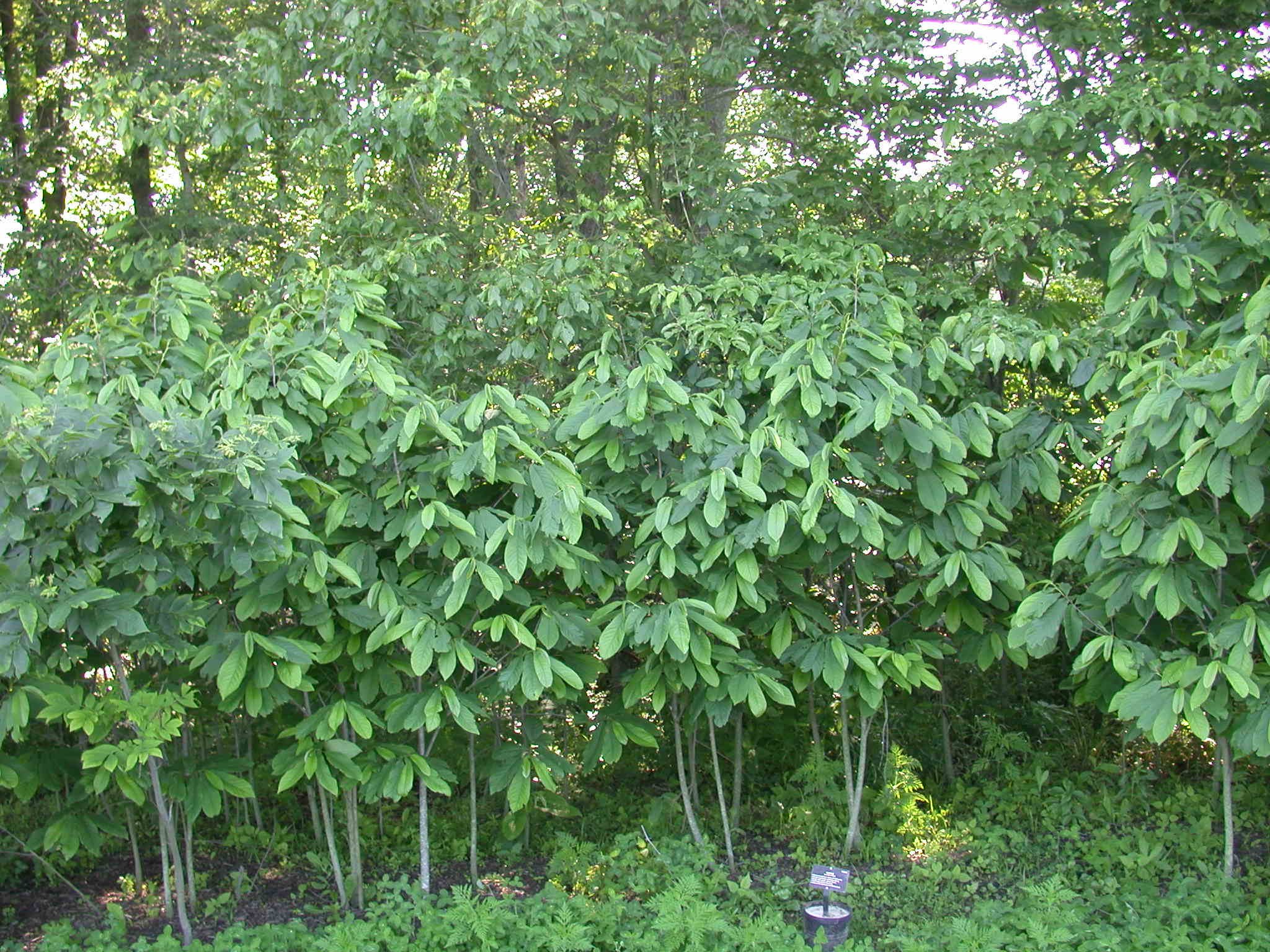Pawpaw
Asimina triloba. Slowly gaining traction as one of the lesser known but spectacular temperate native fruits. Native to eastern North America west to Michigan and Kansas and at its northern extent in New York, pawpaw was a popular food source among native Americans. It has a hard to describe, somewhat tropical flavor similar to banana or mango but like a custard (its part of the Annonaceae or custard apple family). It was very popular throughout the early history of the United States until deforestation and expansion wiped out many wild populations. The fruit also bruises easily, perishes quickly, and does not lend itself to industrialized agriculture. It has seen a resurgence in popularity due mostly to backyard growers and hobbyists. These seedlings are grown from parentage of the well-known KSU breeding program.
The pawpaw can grow up to 40 feet tall but more typically around 20-25 feet with a rounded, lollipop like shape and similar width. Prone to suckering, especially in shady conditions, they tend grow best in groups. Does best in rich, well-drained soils. They will fruit in shade but do best in full sun. Deer resistant, virtually disease and pest free, and juglons tolerant, establishment can be slow at first but will take off after a few years.
Depending on the variety, pawpaw fruits vary in size, time of ripening, and flavor. Malodorous, purple/brown, 5-petal flowers appear in spring before the leaves. The fruits resemble stubby bananas and the skin turns brown as the fruit ripens. Make sure to eat them before the skin turns dark brown as they develop higher concentrations of annonacin, a known neurotoxin. Skin and seeds are toxic but the fruits are perfectly healthy, just not in massive quantities. Don’t overdue it! In any cases where overconsumption of Asimina fruits has resulted in neurological problems, the cessation of consumption was all that was needed to reverse the pathology.
Sold as bare root seedlings 12-18” tall.
Asimina triloba. Slowly gaining traction as one of the lesser known but spectacular temperate native fruits. Native to eastern North America west to Michigan and Kansas and at its northern extent in New York, pawpaw was a popular food source among native Americans. It has a hard to describe, somewhat tropical flavor similar to banana or mango but like a custard (its part of the Annonaceae or custard apple family). It was very popular throughout the early history of the United States until deforestation and expansion wiped out many wild populations. The fruit also bruises easily, perishes quickly, and does not lend itself to industrialized agriculture. It has seen a resurgence in popularity due mostly to backyard growers and hobbyists. These seedlings are grown from parentage of the well-known KSU breeding program.
The pawpaw can grow up to 40 feet tall but more typically around 20-25 feet with a rounded, lollipop like shape and similar width. Prone to suckering, especially in shady conditions, they tend grow best in groups. Does best in rich, well-drained soils. They will fruit in shade but do best in full sun. Deer resistant, virtually disease and pest free, and juglons tolerant, establishment can be slow at first but will take off after a few years.
Depending on the variety, pawpaw fruits vary in size, time of ripening, and flavor. Malodorous, purple/brown, 5-petal flowers appear in spring before the leaves. The fruits resemble stubby bananas and the skin turns brown as the fruit ripens. Make sure to eat them before the skin turns dark brown as they develop higher concentrations of annonacin, a known neurotoxin. Skin and seeds are toxic but the fruits are perfectly healthy, just not in massive quantities. Don’t overdue it! In any cases where overconsumption of Asimina fruits has resulted in neurological problems, the cessation of consumption was all that was needed to reverse the pathology.
Sold as bare root seedlings 12-18” tall.
Asimina triloba. Slowly gaining traction as one of the lesser known but spectacular temperate native fruits. Native to eastern North America west to Michigan and Kansas and at its northern extent in New York, pawpaw was a popular food source among native Americans. It has a hard to describe, somewhat tropical flavor similar to banana or mango but like a custard (its part of the Annonaceae or custard apple family). It was very popular throughout the early history of the United States until deforestation and expansion wiped out many wild populations. The fruit also bruises easily, perishes quickly, and does not lend itself to industrialized agriculture. It has seen a resurgence in popularity due mostly to backyard growers and hobbyists. These seedlings are grown from parentage of the well-known KSU breeding program.
The pawpaw can grow up to 40 feet tall but more typically around 20-25 feet with a rounded, lollipop like shape and similar width. Prone to suckering, especially in shady conditions, they tend grow best in groups. Does best in rich, well-drained soils. They will fruit in shade but do best in full sun. Deer resistant, virtually disease and pest free, and juglons tolerant, establishment can be slow at first but will take off after a few years.
Depending on the variety, pawpaw fruits vary in size, time of ripening, and flavor. Malodorous, purple/brown, 5-petal flowers appear in spring before the leaves. The fruits resemble stubby bananas and the skin turns brown as the fruit ripens. Make sure to eat them before the skin turns dark brown as they develop higher concentrations of annonacin, a known neurotoxin. Skin and seeds are toxic but the fruits are perfectly healthy, just not in massive quantities. Don’t overdue it! In any cases where overconsumption of Asimina fruits has resulted in neurological problems, the cessation of consumption was all that was needed to reverse the pathology.
Sold as bare root seedlings 12-18” tall.




